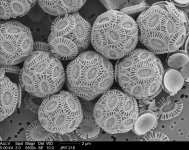Just saw this pic online of chalk under a microscope. Probably not billiards chalk (missing the "sand"?), but pretty close I imagine.
Maybe Dr. Dave has a pic of billiards chalk under a microscope?
pj
chgo
View attachment 75493
Maybe Dr. Dave has a pic of billiards chalk under a microscope?
pj
chgo
View attachment 75493
